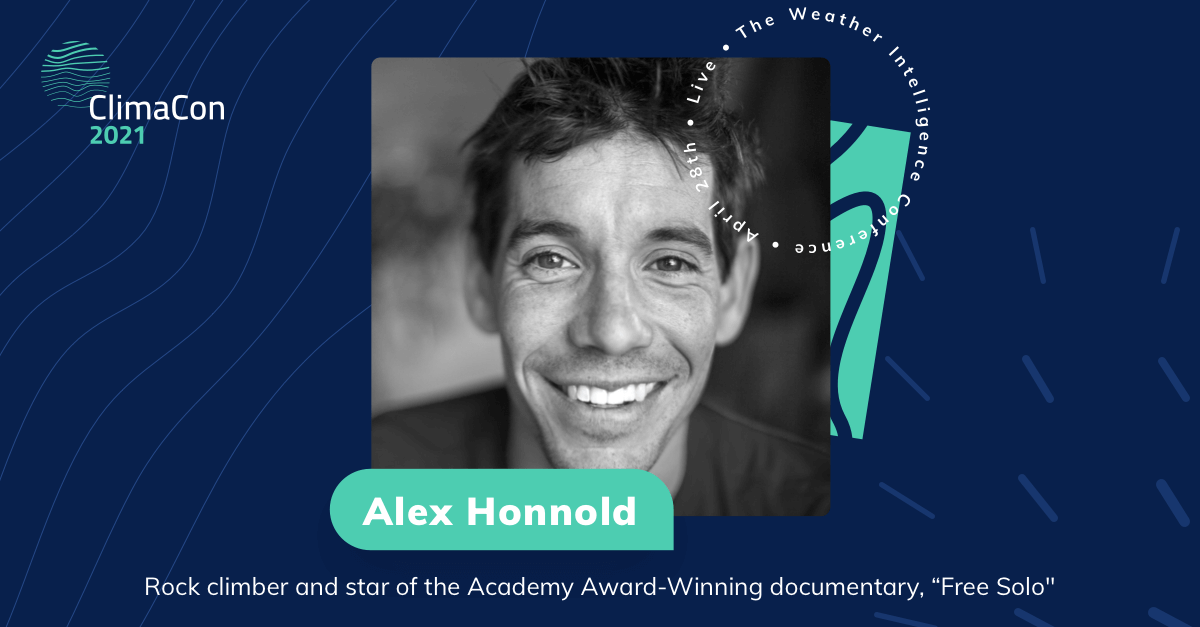Anyone who’s headed out for a hike only to get rained on knows how much the weather can make a fun day into a potentially dangerous one when mountains are involved.
But what if you’re hanging off the side of the cliff, with no ropes or support?
It’s a recipe for disaster.
That’s why world-class free solo climber Alex Honnold obsesses over the weather before making climbs like his epic ascent of 3,000 ft El Capitan in Yosemite National Park…without a rope.
“Honestly, weather is one of the biggest factors in climbing. And not just dramatic weather, but general conditions. Is it hot? Is it humid? Is it windy? You can’t force it if the weather is bad.” – Alex Honnold, star of the Academy Award-winning documentary, Free Solo
We sat down with Honnold during ClimaCon 2021 to talk through how weather impacts climbers and what that means for the future.
How Daily Weather Impacts Rock Climbing
For Honnold, every day starts with checking the weather forecast. Rain or snow is just the beginning of what he’s contending with as a free soloist. With razor-thin margins for error, everything has to be just right.
If you’ve seen the film Free Solo, then you know Honnold’s first attempt at El Capitan actually ended in failure — and weather played a major role. But whether it’s big climbs or everyday training, every season of climbing brings new weather challenges to deal with.
“In the fall, the days are shorter. You have to start in the dark in order to make it to a certain section before the sun gets on the wall. So you’re thinking about where the sun tracks in the sky, what time sunrise is, and the temperature over time. In the spring, there can be runoff on the wall, which means the snow is melting in the high country. Water comes out of the cracks, making it slippery. And in the summer, it gets so hot that you’re basically burned when you touch the rock. You’re constantly juggling all of these different variables to optimize conditions for a successful climb.”
When Honnold evaluates whether or not to take on a project, he’s thinking about way more than the day-to-day weather conditions. Wind speed, temperature changes, shade and sun, moon position for nighttime starts, and more all impact his decision to go for it or not. It’s critical to completely understand the terrain ahead of any solo climbs, getting to know the feel of each rock, each hold.
“There’s no shortcut to experience. You have to put the time in. I’ve spent maybe ten or fifteen springtimes in Yosemite now. Each spring, you experience the runoff from high country and see how it dries up in the course of a season, so you can track how wet it will be on the rock each morning. There’s an ebb and flow of constantly changing daily conditions, which is why detailed forecasts are so important.”
When a Storm Means the Difference Between Life and Death
But weather can also be more dramatic. Alex Honnold spends plenty of time in Patagonia, a region of South America known for wild wind and unpredictable weather that changes on a dime. The crew hiked in to bag one of Patagonia’s iconic granite spires…only to have weather get in the way.
It turned an exciting challenge into one of the most dangerous few days of Honnold’s life.
“It’s hard to get an accurate forecast three or four days out down there. We thought we had a 48-hour window of calm conditions, but we made a bad call. We started climbing, doing nearly 24 hours of continuous climbing up and over these peaks. But toward the last peak, it became nuclear, completely dark, raging wind, and a huge temperature drop. We were clipped into this ice wall, hanging there and holding each other all night hoping we’d get the chance to rapel back down. We had to do the final 24 hours without food or gear since it all blew away. It was a survival situation at that point. When I got out, I immediately changed my flight and flew home. I was so done.”
It’s those kinds of situations that make for good stories — but are less fun when you’re camped out on a ridge, hoping for conditions to change. Success in regions like Patagonia depend on detailed, accurate weather forecasting, which is why more climbers have been able to make attempts in the first place.
Making a bad call isn’t just about a little discomfort. It can be a matter of survival. In fact, 75% of the global population live outside of weather satellite coverage, like in the remote regions of Chile and Argentina that make up Patagonia. That’s why at Tomorrow.io, we’re building proprietary satellites designed to improve weather monitoring and forecasting capabilities even in remote regions.
Get Better Forecasts with Tomorrow
For climbers like Honnold, a better weather forecast can make all the difference.
“It would be safer for everyone. I spend a lot of my time managing risk, and the weather underscores everything that I do. If it’s too cold or windy, you can’t climb and that’s the way it is. It’s a very underappreciated aspect of what we do as climbers. We’re really at the whims of the natural world.”
Want to hear more from Alex Honnold? Watch his full session from the ClimaCon 2021.















